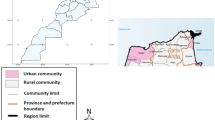Abstract
Landsat-5 Thematic Mapper (TM) dataset have been used to estimate salinity in the coastal area of Hong Kong. Four adjacent Landsat TM images were used in this study, which was atmospherically corrected using the Second Simulation of the Satellite Signal in the Solar Spectrum (6S) radiative transfer code. The atmospherically corrected images were further used to develop models for salinity using Ordinary Least Square (OLS) regression and Geographically Weighted Regression (GWR) based on in situ data of October 2009. Results show that the coefficient of determination (R2) of 0.42 between the OLS estimated and in situ measured salinity is much lower than that of the GWR model, which is two times higher (R2 = 0.86). It indicates that the GWR model has more ability than the OLS regression model to predict salinity and show its spatial heterogeneity better. It was observed that the salinity was high in Deep Bay (north-western part of Hong Kong) which might be due to the industrial waste disposal, whereas the salinity was estimated to be constant (32 practical salinity units) towards the open sea.
Similar content being viewed by others
References
Alvera-Azcárate, A., Barth, A., Parard, G., and Beckers, J. M., 2016. Analysis of SMOS sea surface salinity data using DINEOF. Remote Sensing of Environment, 180: 137–145.
Census and Statistics Department, 2017. Population. Available online at http://www.censtatd.gov.hk/hkstat/sub/so20.jsp (last accessed: 28 February, 2017).
Chen, L., Alabbadi, B., Tan, C. H., Wang, T. S., and Li, K. C., 2016. Predicting sea surface salinity using an improved genetic algorithm combining operation tree method. Journal of the Indian Society of Remote Sensing, 45 (4): 699–707.
D’Sa, E. J., Zaitzeff, J. B., and Steward, R. G., 2000. Monitoring water quality in Florida Bay with remotely sensed salinity and in situ bio-optical observations. International Journal of Remote Sensing, 21: 811–816.
Fotheringham, A. S., Charlton, M. E., and Brunsdon, C., 1998. Geographically weighted regression: A natural evolution of the expansion method for spatial data analysis. Environment and Planning A, 30 (11): 1905–1927.
Fortheringham, A. S., 1993. On the future of spatial analysis: The role of GIS. Environment and Planning A, 25: 30–34.
Gillanders, B., and Kingsford, M., 2002. Impact of changes in flow of freshwater on estuarine and open coastal habitats and the associated organisms. Oceanography and Marine Biology, 40: 233–309.
Harvey, E. T., Kratzer, S., and Andersson, A., 2015. Relationships between colored dissolved organic matter and dissolved organic carbon in different coastal gradients of the Baltic Sea. Ambio, 44 (Suppl. 3): 392–401.
Hong Kong Environmental Protection Department, 2016. Marine water quality in Hong Kong in 2015. Environmental Protection Department, Hong Kong. DOI: http://www.epd.gov.hk/epd/.
Lavery, P., Pattiaratchi, C., Wyllie, A., and Hick, P., 1993. Water quality monitoring in estuarine waters using the landsat the matic mapper. Remote Sensing of Environment, 46: 268–280.
Li, C., Zhao, H., Li, H., and Lv, K., 2016. Statistical models of sea surface salinity in the South China Sea based on SMOS satellite data. IEEE Journal of Selected Topics in Applied Earth Observations and Remote Sensing, 9: 2658–2664.
Meier, H., Eilola, K., and Almroth, E., 2011. Climate-related changes in marine ecosystems simulated with a 3-dimensional coupled physical-biogeochemical model of the Baltic Sea. Climate Research, 48: 31–55, DOI: 10.3354/cr00968.
Nazeer, M., and Nichol, J. E., 2015. Combining landsat TM/ ETM+ and HJ-1 A/B CCD sensors for monitoring coastal water quality in Hong Kong. IEEE Geoscience and Remote Sensing Letters, 12 (9): 1898–1902.
Nazeer, M., and Nichol, J. E., 2016a. Development and application of a remote sensing-based chlorophyll-a concentration prediction model for complex coastal waters of Hong Kong. Journal of Hydrology, 532: 80–89.
Nazeer, M., and Nichol, J. E., 2016b. Improved water quality retrieval by identifying optically unique water classes. Journal of Hydrology, 541: 1119–1132.
Nazeer, M., Nichol, J. E., and Yung, Y. K., 2014. Evaluation of atmospheric correction models and Landsat surface reflectance product in an urban coastal environment. International Journal of Remote Sensing, 35: 6271–6291.
Qi, Z., and Wei, E., 2012. Analysis of cost functions for retrieving sea surface salinity. Journal of Ocean University of China, 11: 147–152.
Rudek, J., Paerl, H. W., Mallin, M. A., and Bates, P. W., 1991. Seasonal and hydrological control of phytoplankton nutrient limitation in the lower Neuse River Estuary, North Carolina. Marine Ecology Progress Series, 75: 133–142.
Vermote, E. F., Tanré, D., DeuzéHerman, J. L., Herman, M., Morcrette, J. J., and Kotchenova, S. Y., 2006. Second Simulation of a Satellite Signal in the Solar Spectrum–Vector (6SV), 6S user guide, version 3. International Geoscience & Remote Sensing Symposium, 1–55.
Xie, Z., Zhang, C., and Berry, L., 2013. Geographically weighted modelling of surface salinity in Florida Bay using Landsat TM data. Remote Sensing Letters, 4: 75–83.
Zhao, H., Li, C., Li, H., Lv, K., and Zhao, Q., 2016. Retrieve sea surface salinity using principal component regression model based on SMOS satellite data. Journal of Ocean University of China, 15 (3): 399–406.
Acknowledgements
Authors would like to acknowledge the Hong Kong Environmental Protection Department (EPD) for providing the in-situ salinity data and the U.S. Geological Survey for providing Landsat TM images. The National Key Research and Development Program of China (No. 2016 YFC1400901) has sponsored this research.
Author information
Authors and Affiliations
Corresponding author
Rights and permissions
About this article
Cite this article
Nazeer, M., Bilal, M. Evaluation of Ordinary Least Square (OLS) and Geographically Weighted Regression (GWR) for Water Quality Monitoring: A Case Study for the Estimation of Salinity. J. Ocean Univ. China 17, 305–310 (2018). https://doi.org/10.1007/s11802-018-3380-6
Received:
Revised:
Accepted:
Published:
Issue Date:
DOI: https://doi.org/10.1007/s11802-018-3380-6




